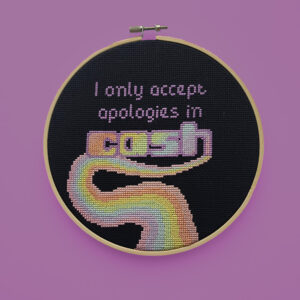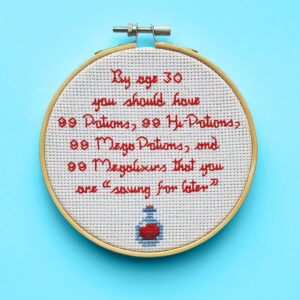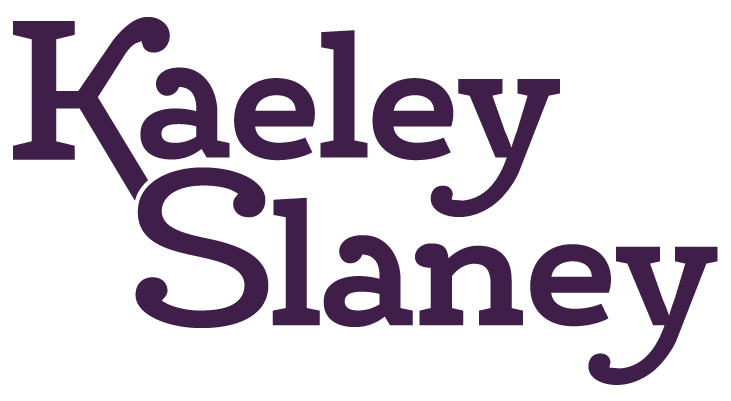Cross Stitch Design: Personal Creative Practice & Side Hustle
I picked up cross-stitching for the first time in 2019. I was a year into my time at Purdys Chocolatier, which I had realized was such a creatively demanding job. I felt as if I was funneling all of my creativity into my day job and had nothing left for myself, which, as a weird art kid who became a creative professional, was a bit of a weird feeling. My art and creativity used to be just for myself, but that’s not the reality of being a working creative. Your creativity and vision are being used to further your employer’s goals. So my thought was to start making something with my hands that was just for me, that wasn’t just making graphic design work or digital art on the computer. I had seen people on Tumblr creating cross stitch designs based on video game pixel art and memes and I was in love. My first piece was the Pokemon Jigglypuff with “one tuff puff” under it in basic sans-serif lettering, a gift for a close friend. My second piece was my first custom piece, pixel art of a tattoo artist’s dog as a gift for the work she had done on me, and from then on, I was hooked.
 2020 was a year. The pandemic had cut my hours and I was unable to see friends outside of my little household bubble. It was an isolating time, but it meant I had a lot of time for myself and my hobbies. I got more serious about my cross stitch design work and started selling my designs as patterns, mostly as a “well, I’ve made the pattern anyway for myself, might as well try to make a bit of money on work that’s already done”. You know, a kind of passive income stream. My little hobby turned business gave me something to focus on during a pretty dark time.
2020 was a year. The pandemic had cut my hours and I was unable to see friends outside of my little household bubble. It was an isolating time, but it meant I had a lot of time for myself and my hobbies. I got more serious about my cross stitch design work and started selling my designs as patterns, mostly as a “well, I’ve made the pattern anyway for myself, might as well try to make a bit of money on work that’s already done”. You know, a kind of passive income stream. My little hobby turned business gave me something to focus on during a pretty dark time.
 I approach designing cross stitches very selfishly. Each piece is for me first and foremost. My interests, my aesthetics, my ideas, my inspirations, my experiments. (This isn’t really how one should run a business, but this is my creative outlet that I just happen to monetize.) I enjoy the restrictions that working with cross stitch as a medium has: limited colour palette, fabric size, and colour, and you’re working square by square. I like tongue-in-cheek and sarcastic humour and I like typography. I’m liberal with swearing and I’m not afraid to poke fun at myself. I like cute things and I want to wear cute things. I like that my cross-stitch designs are a reflection of myself both as a creative and as an individual.
I approach designing cross stitches very selfishly. Each piece is for me first and foremost. My interests, my aesthetics, my ideas, my inspirations, my experiments. (This isn’t really how one should run a business, but this is my creative outlet that I just happen to monetize.) I enjoy the restrictions that working with cross stitch as a medium has: limited colour palette, fabric size, and colour, and you’re working square by square. I like tongue-in-cheek and sarcastic humour and I like typography. I’m liberal with swearing and I’m not afraid to poke fun at myself. I like cute things and I want to wear cute things. I like that my cross-stitch designs are a reflection of myself both as a creative and as an individual.
 Like most things you go into without a lot of knowledge, I’ve learned a lot of best practices over time and have adapted my processes to make a better experience for others. Reading about other’s struggles has highlighted the importance of legibility. As a designer, this is always back of mind, but I wasn’t always thinking about it correctly. Cross stitch patterns use a legend with symbols to differentiate colours and, as someone who doesn’t struggle with any visual impairments or learning difficulties, I just assumed that my symbol choice was fine because I could read them. Reading about the experiences of people who struggle gave me a lot to chew on, so I did indeed adjust my legends to up the contrast between shapes. I’ve also adapted my workflow over time. Some key preliminary information: the computer that I’m currently working on is a laptop and it’s old. Adobe programs are not nice to computers like this. I was originally creating my designs and patterns entirely in Illustrator, which created enormous files that absolutely throttled my system. Thinking about my workflow further: I was making a PDF document as an end result. Why was I not making that in InDesign with images linked from Illustrator? (Key finding: patterns from Adobe Illustrator DO NOT play nice with every PDF reader, expand those buggers.)
Like most things you go into without a lot of knowledge, I’ve learned a lot of best practices over time and have adapted my processes to make a better experience for others. Reading about other’s struggles has highlighted the importance of legibility. As a designer, this is always back of mind, but I wasn’t always thinking about it correctly. Cross stitch patterns use a legend with symbols to differentiate colours and, as someone who doesn’t struggle with any visual impairments or learning difficulties, I just assumed that my symbol choice was fine because I could read them. Reading about the experiences of people who struggle gave me a lot to chew on, so I did indeed adjust my legends to up the contrast between shapes. I’ve also adapted my workflow over time. Some key preliminary information: the computer that I’m currently working on is a laptop and it’s old. Adobe programs are not nice to computers like this. I was originally creating my designs and patterns entirely in Illustrator, which created enormous files that absolutely throttled my system. Thinking about my workflow further: I was making a PDF document as an end result. Why was I not making that in InDesign with images linked from Illustrator? (Key finding: patterns from Adobe Illustrator DO NOT play nice with every PDF reader, expand those buggers.)
 2020 was a year. The pandemic had cut my hours and I was unable to see friends outside of my little household bubble. It was an isolating time, but it meant I had a lot of time for myself and my hobbies. I got more serious about my cross stitch design work and started selling my designs as patterns, mostly as a “well, I’ve made the pattern anyway for myself, might as well try to make a bit of money on work that’s already done”. You know, a kind of passive income stream. My little hobby turned business gave me something to focus on during a pretty dark time.
2020 was a year. The pandemic had cut my hours and I was unable to see friends outside of my little household bubble. It was an isolating time, but it meant I had a lot of time for myself and my hobbies. I got more serious about my cross stitch design work and started selling my designs as patterns, mostly as a “well, I’ve made the pattern anyway for myself, might as well try to make a bit of money on work that’s already done”. You know, a kind of passive income stream. My little hobby turned business gave me something to focus on during a pretty dark time.
 I approach designing cross stitches very selfishly. Each piece is for me first and foremost. My interests, my aesthetics, my ideas, my inspirations, my experiments. (This isn’t really how one should run a business, but this is my creative outlet that I just happen to monetize.) I enjoy the restrictions that working with cross stitch as a medium has: limited colour palette, fabric size, and colour, and you’re working square by square. I like tongue-in-cheek and sarcastic humour and I like typography. I’m liberal with swearing and I’m not afraid to poke fun at myself. I like cute things and I want to wear cute things. I like that my cross-stitch designs are a reflection of myself both as a creative and as an individual.
I approach designing cross stitches very selfishly. Each piece is for me first and foremost. My interests, my aesthetics, my ideas, my inspirations, my experiments. (This isn’t really how one should run a business, but this is my creative outlet that I just happen to monetize.) I enjoy the restrictions that working with cross stitch as a medium has: limited colour palette, fabric size, and colour, and you’re working square by square. I like tongue-in-cheek and sarcastic humour and I like typography. I’m liberal with swearing and I’m not afraid to poke fun at myself. I like cute things and I want to wear cute things. I like that my cross-stitch designs are a reflection of myself both as a creative and as an individual.
 Like most things you go into without a lot of knowledge, I’ve learned a lot of best practices over time and have adapted my processes to make a better experience for others. Reading about other’s struggles has highlighted the importance of legibility. As a designer, this is always back of mind, but I wasn’t always thinking about it correctly. Cross stitch patterns use a legend with symbols to differentiate colours and, as someone who doesn’t struggle with any visual impairments or learning difficulties, I just assumed that my symbol choice was fine because I could read them. Reading about the experiences of people who struggle gave me a lot to chew on, so I did indeed adjust my legends to up the contrast between shapes. I’ve also adapted my workflow over time. Some key preliminary information: the computer that I’m currently working on is a laptop and it’s old. Adobe programs are not nice to computers like this. I was originally creating my designs and patterns entirely in Illustrator, which created enormous files that absolutely throttled my system. Thinking about my workflow further: I was making a PDF document as an end result. Why was I not making that in InDesign with images linked from Illustrator? (Key finding: patterns from Adobe Illustrator DO NOT play nice with every PDF reader, expand those buggers.)
Like most things you go into without a lot of knowledge, I’ve learned a lot of best practices over time and have adapted my processes to make a better experience for others. Reading about other’s struggles has highlighted the importance of legibility. As a designer, this is always back of mind, but I wasn’t always thinking about it correctly. Cross stitch patterns use a legend with symbols to differentiate colours and, as someone who doesn’t struggle with any visual impairments or learning difficulties, I just assumed that my symbol choice was fine because I could read them. Reading about the experiences of people who struggle gave me a lot to chew on, so I did indeed adjust my legends to up the contrast between shapes. I’ve also adapted my workflow over time. Some key preliminary information: the computer that I’m currently working on is a laptop and it’s old. Adobe programs are not nice to computers like this. I was originally creating my designs and patterns entirely in Illustrator, which created enormous files that absolutely throttled my system. Thinking about my workflow further: I was making a PDF document as an end result. Why was I not making that in InDesign with images linked from Illustrator? (Key finding: patterns from Adobe Illustrator DO NOT play nice with every PDF reader, expand those buggers.)








Leave a Reply